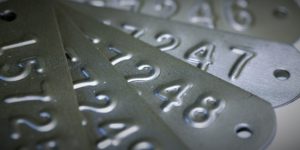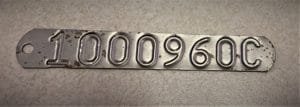Embossing and debossing are very similar methods for marking custom metal tags and nameplates. Both processes utilize a custom die set to create a raised/indented impression, respectively.
While the processes are similar, there are some major differences as well.
Embossing
Process
Embossing is a tried and true marking process used for marking metal tags and nameplates. The process utilizes a male and female die set to press a raised design into a metal substrate.
For each design, a custom embossing die set must be produced. This can then be used in an industrial press to churn out a large quantity of tags.

A custom die leaves a permanent mark that will last for decades. These raised characters provide long distant readability as well as extreme durability.
Note that incorporating multiple designs can get extremely costly.
Embossing Machines
Instead of producing multiple custom embossing die sets, there are special machines made to produce tags with variable information. These embossing machines are primarily used for in-house marking and identification.
Auto-feed embossing machines can grab tags and mark them individually with custom information. This can be significantly more cost effective than producing many custom die sets. However, the automated machines are limited to only basic text and numbers.
Durability
The embossing process is one of the most durable marking solutions for custom ID tags. The raised characters produced are extremely resilient.
Essentially, as long as the metal tag itself is there, the text will be legible. In order for the impressions to wear, the metal itself would need to be worn away.
Embossing is usable in nearly any type of environment. Weather is not a problem as there is no topical ink to wear or fade with UV light exposure. Even if the tag is covered in dirt, paint, or oil, the characters will remain legible.
The process is trusted as a proven standard in some of the harshest industrial environments. From oil rigs to manufacturing plants, the process is relied upon across the board.
Materials
Aluminum
Aluminum is very popular for embossing. The material is lauded for its durability, but lightweight properties. The metal provides clear impressions when marked by an embossing press.
If the aluminum is treated with the anodization process, it offers the additional benefit of solid coloring. This can be used to color code machines, or for branding purposes.
Stainless Steel
For the highest level of durability in an embossed tag or nameplate, many organizations opt for stainless steel.
Stainless steel is suitable for the harshest level of industrial conditions. It can withstand corrosion, water, extreme temperatures, and more.
Applications
Embossed nameplates are the standard in some of the toughest industries.
Some examples of embossed tag applications:
- Safety Release Valve Tags
- Asset Tags
- Utility Pole Tags
- Superelevation Markers
- Job Tags
Debossing
Debossing and embossing are incredibly similar as far as marking processes go. Both processes create their designs using a male/female die set. The biggest differences are the direction which the design is imprinted, as well as how the tags are used.
Process
The actual process for marking a debossed design is very similar to the embossing process. The custom made die set produces an indented design in the metal material. While embossing creates characters that are raised upwards, debossing imprints the design downwards. In other words, the reverse side of the tag will have the raised impressions.
A quick way to tell the difference between embossing and debossing is to look at the back of the marked nameplate. If that side is indented then it is likely an embossed design. If the back sports raised markings, it would be considered debossed.

Similarly, it is easy to differentiate debossing from stamping as the backside of a debossed tag will not be flat like it is on a stamped plate.
Durability
Just like the embossing process, debossed tags are extremely durable. No topical ink or printed designs means nothing to wear or fade except for the physical impressions in the metal.
Material
Again, the similarities between the two processes apply to material options as well. The two most commonly used materials for debossing are aluminum and stainless steel. Both materials are incredibly versatile and durable.
The materials are suitable for nearly any type of industrial environment, both indoor and outdoor.
Anodized aluminum offers extra corrosive resistance, as well as the ability for colorization. Stainless steel provides the highest level of durability.
Applications
Debossed tags are not commonly used as a standard identification tag. While they certainly can be, there are few situations in which a debossed design is preferable to a raised one.
Instead, the debossed part is often used as a marking tool. The protruding characters on the reverse of the tag are often pressed into a soft item to leave a lasting imprint.
For example, tire manufacturers sometimes use this type of tag to imprint a custom design or number into a rubber tire as it is formed. This produces a permanent impression in the new tire, without requiring additional work.
The debossed tag can be used over and over again for this process as well.
Wrap-Up
There are more similarities than differences when it comes to embossing and debossing. Both processes produce an extremely durable, raised character solution.
Embossing provides characters raised upwards in the front, while debossing produces a design pressed outwards toward the reverse side.
Both solutions are durable enough to hold up in harsh weather conditions.
Embossing is used in countless industrial applications. From providing traceability of assets, to marking safety information, there is hardly a limit to the number of uses for embossed tags.
Debossing is not as often used in the same applications, but provides a useful solution. It’s unique backward raising make it suitable for highly specified niche applications.